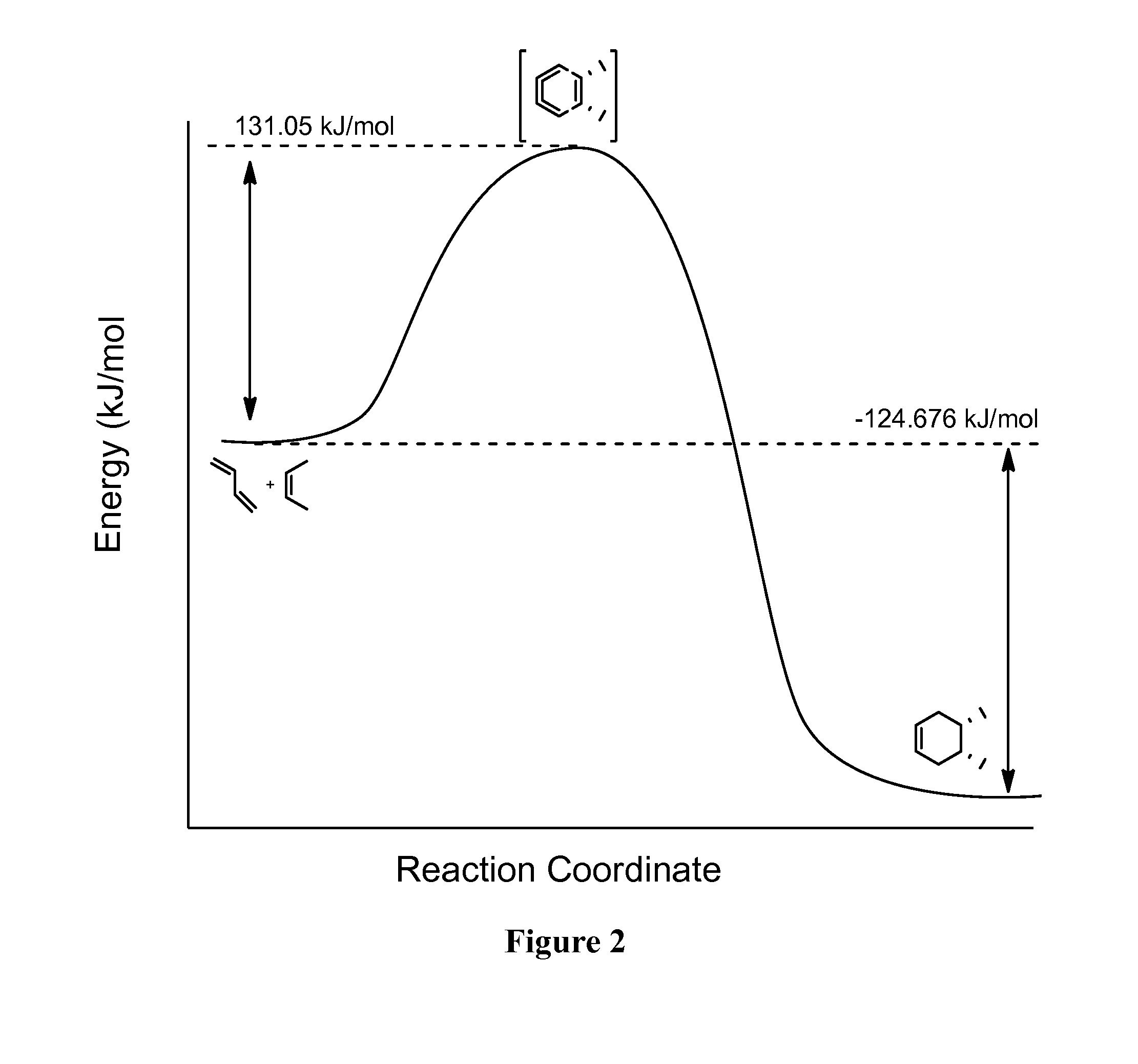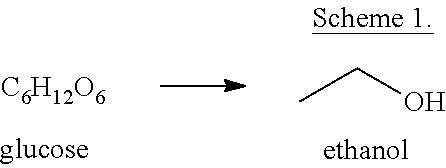Methods of preparing para-xylene from biomass
a technology of bioparaxylene and biomass, which is applied in the direction of hydrocarbon preparation catalysts, hydrocarbons from oxygen organic compounds, hydrocarbons, etc., can solve the problems of complex process, high cost, and high cost of petrochemical source materials, and achieves the effect of high activity ratio of diene, increased reaction rate and reduced cos
- Summary
- Abstract
- Description
- Claims
- Application Information
AI Technical Summary
Benefits of technology
Problems solved by technology
Method used
Image
Examples
example 1
Diels-Alder Cycloaddition of Hexa-2,4-diene and Ethylene
[0106]The reaction coordinate of the Diels-Alder cycloaddition of hexa-2,4-diene and ethylene to give 3,6-dimethylcyclohex-1-ene is shown in FIG. 1. Computationally calculated temperature, activity ratios and reaction rates of the Diels-Alder cycloaddition are shown in Table 1, and are based on the Eyering equation:
k=(kBt / h)(−Ea / RT) [0107]where k=rate constant;[0108]KB=Boltzmann constant;[0109]T=temperature;[0110]h=Plank's constant; and[0111]Ea=Activation energy (143.1 kJ / mol)
[0112]The “Ratio” is defined as the moles of ethylene to moles of hexa-2,4-diene.
TABLE 1TemperatureRatioK° C.k (1 / s)125102550100298.15255.27E−165.27E−161.05E−152.64E−155.27E−151.32E−142.64E−145.27E−14303.15301.39E−151.39E−152.78E−156.94E−151.39E−143.47E−146.94E−141.39E−13308.15353.55E−153.55E−157.09E−151.77E−143.55E−148.87E−141.77E−133.55E−13313.15408.79E−158.79E−151.76E−144.40E−148.79E−142.20E−134.40E−138.79E−13318.15452.12E−142.12E−144.24E−141.06E−132.12...
example 2
Diels-Alder Cycloaddition of Hexa-2,4-diene and Ethylene
[0113]The reaction coordinate of the Diels-Alder cycloaddition of buta-1,3-diene and 2-butene to produce the [4+2] cycloadduct, 4,5-dimethylcyclohex-1-ene is shown in FIG. 2. Computationally calculated temperature, activity ratios and reaction rates of the Diels-Alder cycloaddition are shown in Table 2, and are based on the Eyering equation:
k=(kBt / h)(−Ea / RT) [0114]where k=rate constant;[0115]KB=Boltzmann constant;[0116]h=Plank's constant;[0117]T=temperature; and[0118]Ea=Activation energy (131.05 kJ / mol)
[0119]The “Ratio” is defined as the molar concentration of 2-butene to the molar concentration of buta-1,3-diene.
TABLE 2TemperatureRatioK° C.k (1 / s)125102550100298.15256.81E−146.81E−141.36E−133.40E−136.81E−131.70E−123.40E−126.81E−12303.15301.66E−131.66E−133.31E−138.28E−131.66E−124.14E−128.28E−121.66E−11308.15353.91E−133.91E−137.82E−131.96E−123.91E−129.78E−121.96E−113.91E−11313.15409.00E−139.00E−131.80E−124.50E−129.00E−122.25E−114...
PUM
| Property | Measurement | Unit |
|---|---|---|
| temperature | aaaaa | aaaaa |
| temperature | aaaaa | aaaaa |
| temperature | aaaaa | aaaaa |
Abstract
Description
Claims
Application Information
 Login to View More
Login to View More - R&D
- Intellectual Property
- Life Sciences
- Materials
- Tech Scout
- Unparalleled Data Quality
- Higher Quality Content
- 60% Fewer Hallucinations
Browse by: Latest US Patents, China's latest patents, Technical Efficacy Thesaurus, Application Domain, Technology Topic, Popular Technical Reports.
© 2025 PatSnap. All rights reserved.Legal|Privacy policy|Modern Slavery Act Transparency Statement|Sitemap|About US| Contact US: help@patsnap.com



